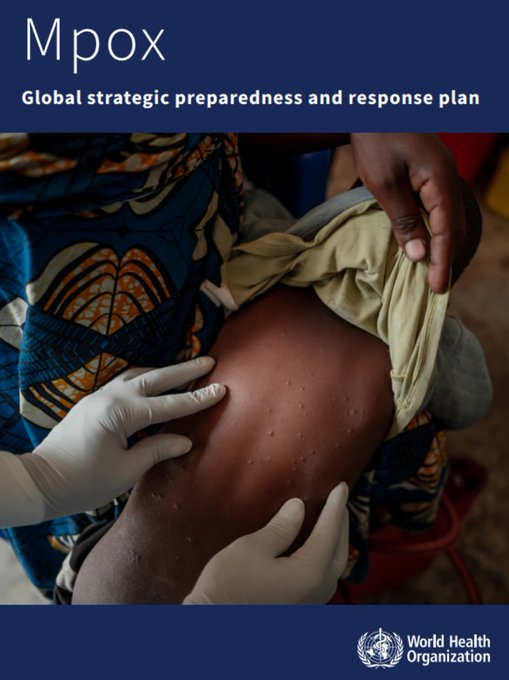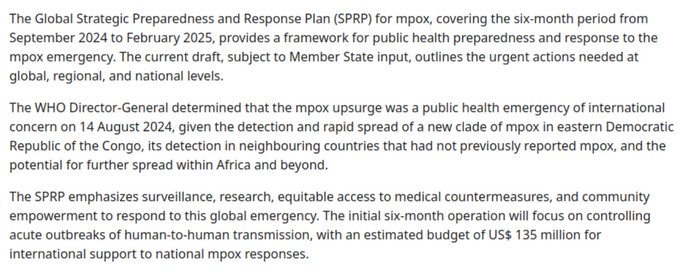Addis Ababa/Brazzaville/Geneva – As the mpox disease continues to spread to new regions, the World Health Organisation (WHO) and the Africa Centers for Disease Control and Prevention (Africa CDC) have revised their joint Continental Response Plan for the outbreak.
In addition to increasing vaccine coverage and moving toward a longer-term, sustainable response, the updated approach concentrates on outbreak control.
The virus that causes mpox primarily spreads through intimate contact. In addition to painful skin and mucosal lesions, it frequently produces fever, headaches, back pain, muscular aches, exhaustion, and enlarged lymph nodes. The illness can be disfiguring and incapacitating.
Previously, a zoonotic illness spread by infected animals, mpox, has recently demonstrated a growing propensity to spread among humans.
“Clade IIb, a viral strain, started to spread through sexual contact around the world in 2022. Clade Ib, another form of the virus, started to spread through close contact, families, and sexual networks in late 2023,” reads a joint statement from the Africa CDC and WHO.
In August 2024, the Director General of the Africa CDC proclaimed mpox a Public Health Emergency of Continental Security in response to the escalating public health threat. The urgent need for coordinated action across nations and regions was highlighted by the World Health Organisation’s declaration of a public health emergency of international concern.
What is the state of the mpox outbreak on the African continent
The virus started to spread from the Democratic Republic of the Congo (DRC) to four neighbouring countries by August 2024. Since then, mpox cases caused by clade Ib have been recorded in 28 different countries.
The majority of cases outside of Africa are still connected to travel. However, local transmission has now been reported in other African nations, including the DRC, South Africa, South Sudan, Tanzania, Burundi, Kenya, Rwanda, and Uganda, in addition to Burundi.
Regional and international support has grown since the emergency was declared, especially for the outbreak’s epicentre, the DRC.
“The ten main pillars of the Africa CDC and WHO Joint Continental Mpox Plan—coordination, risk communication and community engagement, disease surveillance, laboratory capacity, clinical management, infection prevention and control, vaccination, research, logistics, and preserving critical health services—have served as the framework for these initiatives,” the joint statement further reads.
The Africa Centres for Disease Control @AfricaCDC has declared MPox which is sweeping across several African countries as a Public Health Emergency.More than 13,700 cases and 450 deaths have been recorded in the Democratic Republic of Congo this year alone.The virus has
According to the Africa CDC and WHO, over 650,000 doses have been given in six countries as part of ongoing vaccination efforts, with the DRC accounting for 90% of these doses.
How Africa CDC and WHO have stepped up the fight against mpox
Ten countries have received more than a million doses in total, and efforts are still being made to obtain more vaccine supplies.
“The construction of laboratory infrastructure has led to a major increase in diagnostic testing capacity in the DRC, which now has 23 laboratories spread across 12 provinces, up from 2 laboratories in late 2023. It is anticipated that capacity will rise even more when the nation rolls out additional, near-point-of-care diagnostics,” reads the statement.
However, the Africa CDC and WHO disclosed that significant obstacles still exist despite these advancements.
“The public health response and access to critical services are still being hampered by the ongoing fighting and insecurity in the eastern DRC, where mpox is still quite common, as well as the reduction of humanitarian aid. More than US$ 220 million is required across nations and partners to close funding gaps for the mpox response,” say the Africa CDC and WHO.
🇺🇳🏥 The Global Strategic Preparedness and Response Plan (SPRP) for mpox, covering the six-month period from September 2024 to February 2025, provides a framework for public health preparedness and response to the mpox emergency
In addition to taking proactive steps to include mpox in standard medical treatments, the revised Continental Response Plan asks for increased efforts to contain outbreaks.
WHO has revised the worldwide strategy plan to reduce, and where possible, to eliminate, human-to-human transmission of mpox in conjunction with the Continental Response Plan for Africa. 60 nations reported instances of mpox in the first two months of 2025, with the African continent accounting for the majority of cases and fatalities. The global strategy is in line with the United Continental Response Plan,” say the two bodies.
Africa CDC and WHO reiterated that they are still collaborating closely with partners, local communities, and national governments to contain the outbreak, stop transmission, and strengthen public health systems’ long-term resilience.





